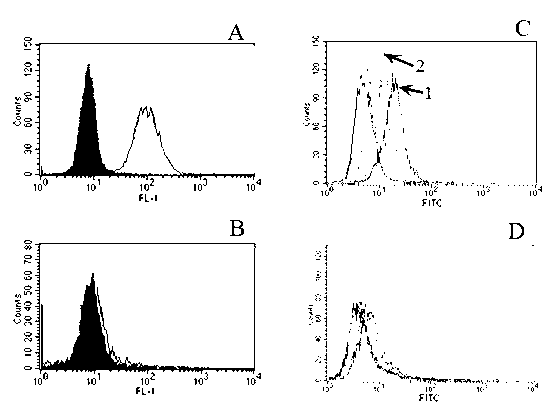Targeted peptide of epidermal growth factor receptor (EGFR) and application thereof
A receptor and targeting technology, applied in the direction of medical preparations containing active ingredients, peptides, polymer compounds, etc., can solve the problem of increasing drug toxicity to the reticuloendothelial system and achieve good EGFR targeting , small molecular weight, convenient synthesis
- Summary
- Abstract
- Description
- Claims
- Application Information
AI Technical Summary
Problems solved by technology
Method used
Image
Examples
Embodiment 1
[0040] EGFR contains 3 main autophosphorylation sites that can regulate the activity of EGFR, namely Y1068, Y1148 and Y1173. The method of sequence comparison / structural analysis is used to design the amino acid sequence derived from the three main sites of action as a small molecule peptide ligand targeting EGFR: EY 1068 INQ, PDY 1148 QQD, AEY 1173 LR.
[0041] In order to screen for small active peptides that bind to EGFR with strong specificity, we synthesized FITC-labeled EYINQ, PDYQQD, AEYLR, RALEL (irrelevant peptides), NYQQN (Mineo Abe, et al. Inhibition of Autophosphorylation of Epidermal Growth Factor Receptor by a Small Peptide Not Employing an ATP-Competitive Mechanism, Biopolymers 89(2007) 40-51. ), and selected LARLLT as a control, and LARLLT was also labeled with FITC. Flow cytometry analysis of the above-mentioned peptides and expression of EGFR (NCI-H1299) ( figure 1 A) and almost no expression of EGFR (K562) ( figure 1 B) The binding rate of different cell lines....
Embodiment 2
[0044] In order to further investigate the binding of each peptide to tumor cells, we carried out an endocytosis experiment (FITC-labeled peptide 10μM incubated with NCI-H1299 and K562 cells at 37°C for 1 hour), such as figure 2 As shown, both FITC-AEYLR and FITC-LARLLT can effectively mediate endocytosis, but K562 cells have no such effect. The experimental results are consistent with Example 1.
Embodiment 3
[0046] To further identify whether this targeting ligand has affinity for human lung cancer biopsy specimens, we used immunohistochemistry to test the reactivity of AEYLR and RALEL with lung adenocarcinoma in patients with lung cancer. Prepare paraffin sections of human lung adenocarcinoma, block the endogenous peroxidase activity, and then incubate with biotin-labeled AEYLR and RALEL. Use HRP-streptavidin to detect with conventional immunohistochemical staining, and use EGFR monoclonal antibody as a control.
[0047] The result is image 3 As shown, biotin-labeled AEYLR can recognize tumor cells in human lung adenocarcinoma biopsy specimens, and the color displayed is close to that of EGFR monoclonal antibody, while biotin-labeled irrelevant peptide RALEL cannot bind to lung adenocarcinoma biopsy specimens without obvious Color changes. These data indicate that AEYLR can recognize EGFR on the surface of cancer cells in patients with lung adenocarcinoma.
PUM
 Login to View More
Login to View More Abstract
Description
Claims
Application Information
 Login to View More
Login to View More - R&D
- Intellectual Property
- Life Sciences
- Materials
- Tech Scout
- Unparalleled Data Quality
- Higher Quality Content
- 60% Fewer Hallucinations
Browse by: Latest US Patents, China's latest patents, Technical Efficacy Thesaurus, Application Domain, Technology Topic, Popular Technical Reports.
© 2025 PatSnap. All rights reserved.Legal|Privacy policy|Modern Slavery Act Transparency Statement|Sitemap|About US| Contact US: help@patsnap.com



